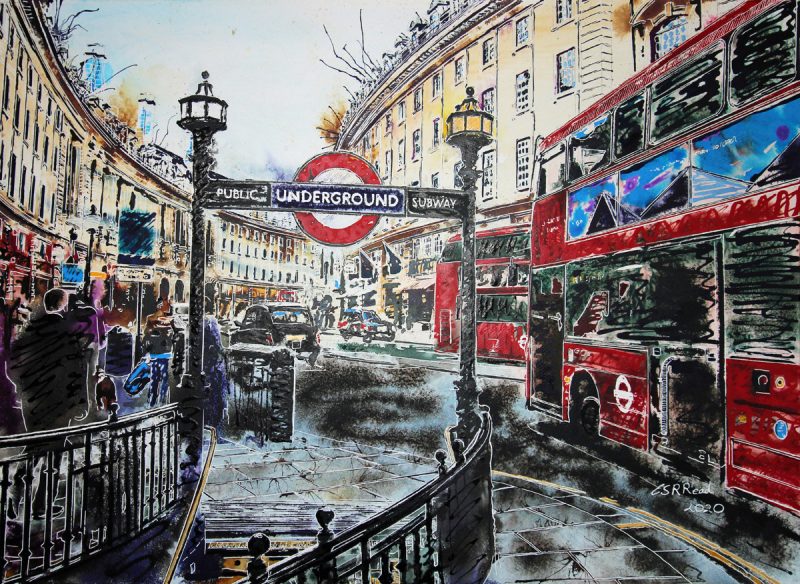“It will quite eclipse Napoleon.” – said the Prince Regent on seeing architect Nash’s plans for Regent Street in 1811.
A sinuous path draws your eye through this Regent Street painting – reminiscent of the intended royal thoroughfare and the world’s first purpose-built shopping centre. As the curved railings meet the road, it carves a sweeping S-shape through the image. Everything heads towards a central vanishing point off to the right.
“And what is around that bend?” I wonder.
I say, “Everything…” But apart from a bus and a taxi heading our way, everthing else turns its back on us, pursuing a course to the distant turn as if to emphasise the disappearing act. Lights frame the bend and an underground sign – its red and white roundel reflected on the passing buses on the right. A third bus is about to vanish around the distant bend. Even the Underground steps seem to beat a determined retreat.
Regent Street in all its glory is impressive.
The architecture, Regency style of course, not named for the street, but for the Prince Regent himself, is distinctive. As a child, in the north of England, I knew Regent Street as a square on the Monopoly board. That was before it became a tangible place to me. I knew that it must be a street, but it was somehow surprising the day I first walked along it – as if fiction had become reality.
My experience may surprise Londoners, and those who frequent its many shops. Luxury shops – where the labels on certain items read ‘Price On Inquiry’, or something similar. A phrase that usually implies to the common man, “If you have to ask, you can’t afford it.” Urban myths have us believe such places are aloof and standoffish. Is this so? Really? I once believed that about galleries, but real life experience disproved those suspicions. One day, after lockdown, I might go and find out about Regent Street shops.
This painting’s Regent Street treats all subjects with an even brushstroke. Its ignoble side bins and a service box are painted with equal care. The busy scene includes shoppers and sightseers. There is even space for a dog: a Springer Spaniel called Arrow – my dog, alongside my husband and son.
Regent Street grandeur
Architect John Nash developed Regent Street in a time when people aspired to grandeur and regality and built to impress. The street is wide enough to feel spacious, yet still sufficiently narrow to emphasize the elegant sweeping curve of buildings. Any wider or narrower and I doubt it would feel quite so impressive. Every detail adds to the glamour. The Underground is grand with lights (one lit, or not). Brass edging defines on the steps flowing down. Curving brass handrails – polished bright by millions of hands stroking them on the way down, or pulling upwards to street level.
In this Regent Street painting, all journeys appear to head somewhere out of sight as they follow that vanishing curve in the centre distance.

Regent Street is one of my London Series.
